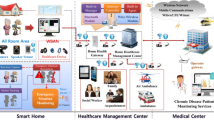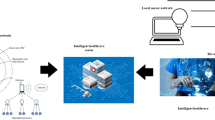Abstract
Two primary concerns for our aging society are preserving good health and avoiding disease. A Smart Home system is one efficient and capable way to find the solution of this complex problem. But, there are several reasons which building a Sma6rt Home is complex. First, it is difficult to accurately track the behavior of the elderly in house, because each person has unique needs and behavior. And also, the system cannot know whether a given behavior is normal or not. Second, medical symptoms are very complex. Third, to get the information in the house, there should be various technologies which use different protocols, data, languages and specifications. In order to solve them, this research which is a part of POSTECH U-Health Smart Home project, was started. This paper makes two significant contributions to the Smart Home Project and autonomic system fields. The first contribution is general architecture for the U-Health Smart Home project through Smart Home at POSTECH. The requirements what kinds of parts are needed to build the Smart Home are introduced and proposed in this paper. The second contribution is a semantic model which can be used by an autonomic system to make accurate and intelligent decisions. To create the appropriate model, various semantic technologies, which use OWL as the programming language, Protégé which version is 3.4.2 as a tool for ontology creation and SWRL as a language for reasoning, were used. Furthermore, for reasonable ontology, open standard CIM version 2.22 is defined and published by DMTF was used as an entire framework.


Similar content being viewed by others
References
Berners-Lee T (2000) The Semantic Web Vision. Keynote session at XML
Noury N (2005) AILISA: Experimental platforms to evaluate remote care and assistive technologies in gerontology. HEALTHCOM 2005(23–25):67–72
Noury N, Rumeau P (2006) Ambient multi-perceptive system for residential health monitoring based on electromic mailings. HEALTHCOM 2006(17–19):95–100
Hsu C-J, Yii-Tay C, Cheng-Lii C, Jlng-Huei H, Jone-Chiung (2008) Telemedicine information monitoring system. HEALTHCOM
UbiSense project. http://www.doc.ic.ac.uk/vip/ubisense/home/home.html
IBM Corporation (2005) An architectural blueprint for autonomic computing. http://www.ginkgo-networks.com/IMG/pdf/AC_Blueprint_White_Paper_V7.pdf
Gruber T (2008) “Ontology”, Encyclopedia of Database Systems. In: Liu LL, Tamer Özsu M (eds) Springer, Berlin
OWL Web Ontology Language Overview. http://www.w3.org/TR/owl-features/
Berners-Lee T, Hendler J, Lassila O (2001) The Semantic Web. Scientific American
SWRL: a semantic web rule language combining OWL and RuleML. http://www.w3.org/Submission/SWRL/
Protégé. http://protege.stanford.edu/
Strassner J Knowledge engineering using ontologies. In: Handbook of Network and System Administration, chapter 3, section 4, pp 425–457
Common Information Model Standard. http://www.dmtf.org/standards/cim/
Resource Description Framework(RDF): Concepts and Abstract Syntax. http://www.w3.org/TR/rdf-concepts/
IBM research (2003) The Vision of Autonomic Computing
Horn P (2001) Autonomic computing: IBM‘s perspective on the state of information technology. IBM Corp. http://www.research.ibm.com/autonomic/research/papers/AC_Vision_Computer_Jan_2003.pdf
Owl, API. http://owlapi.sourceforge.net/
Pellet: OWL 2 Reasoner for Java. http://clarkparsia.com/pellet
Neumann S, Devos A, Widergren S, Britton J (2006) User of the CIM ontology. Distridutech
Berardi D, Calvanese D, De Giacomo G, Santucci G, Perrone A, Vetere G (2003) Using the CIM conceptualization in autonomic system management the system management ontology project. DSOM 2003, Heidelberg
Heimbigner D (2004) DMTF-CIM to OWL: a case study in ontology conversion. SEKE2004, Canada, pp 470–474
Marta M, Bartosz K, Jacek K (2007) Translation of common information model to web ontology language. Lecture Notes in Computer Science, Volume 4487, pp 414–417
CIMTool Project. http://cimtool.org/
CodeBlue project. http://fiji.eecs.harvard.edu/CodeBlue
Duke Smart Home Program. http://www.smarthome.duke.edu/index.php
Franz B (2009) Description Logics. Lecture Notes in Computer Science vol 5689, pp 1–39
Hamed B (2012) Design and implementation of smart house control using LabVIEW. Int J Soft Comput Eng 1(6):98–106
LabVIEW. http://www.ni.com/labview/
Vam Nhuyen T, Kim JG, Choi DJ (2009) ISS: the interactive smart home simulator. Adv Commun Technol Korea 03:1828–1833
Author information
Authors and Affiliations
Corresponding author
Rights and permissions
About this article
Cite this article
Kim, J., Park, S.O. U-Health Smart system architecture and ontology model. J Supercomput 71, 2121–2137 (2015). https://doi.org/10.1007/s11227-014-1334-3
Published:
Issue Date:
DOI: https://doi.org/10.1007/s11227-014-1334-3




